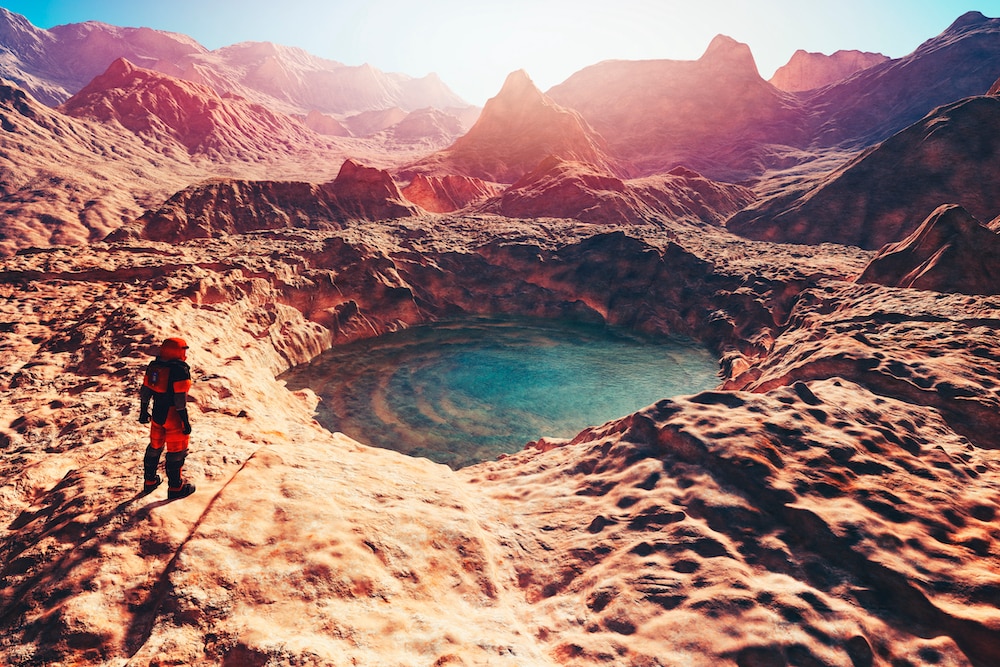Create a free profile to get unlimited access to exclusive videos, sweepstakes, and more!
Could we really terraform Mars like they did in 'The Expanse'?
The Expanse made auroras on Mars possible, but it has no magnetic field — we might be able to change that.

You know that scene in The Expanse where Avarsala and Arjun are gazing at the Martian aurora borealis? It’s a phenomenon that can’t physically happen.
Auroras wouldn’t be possible without a magnetic field, and that wouldn’t be possible unless Mars was terraformed — somehow altered to become more Earthlike. The only way to make northern and southern lights possible on this red and dead planet would be to give it an artificial magnetic field, which would protect its human inhabitants from deadly cosmic rays and interact with charged particles in space to create such a spectacle.
New research shows that there are several ways to give Mars an artificial magnetic field. Those solenoids used in The Expanse could actually work, but sometimes, actual science beats science fiction. Researchers have now come up with an even better way that we might be able to make Mars habitable in the future. Barry Kellett, of the Science and Technology Facilities Council in the U.K., coauthored a study recently published in Acta Astronautica.
“As opposed to a ground-based solution, an orbital solution would involve six or eight satellites that would send a current of plasma between them to surround Mars,” Kellett told SYFY WIRE. “This large current would then have to run through this hexagonal or octagonal plasma ring.”
The Expanse imagines instruments on the ground that would need at least two plasma rings, with one at the northern hemisphere and one at the southern hemisphere. They would generate a magnetic field through superconducting wire loops that were able to carry an intense current. However, the issue with this is the extremely heavy payload that would have to be launched and flown to Mars. The orbital solution wouldn’t require nearly as much stuff crammed in a rocket. Mars already has its own satellites: its moons, Phobos and Deimos.
You would still need to load a nuclear fusion generator on a rocket to take advantage of Phobos (the larger moon) for orbital terraforming. Once the generator landed on Phobos, it would subject surface material to extreme heat until it morphed into a gaseous state or at least vaporized. An electrical current would then be zapped through that gas or vapor to ionize it by removing electrons from the atoms in its particles. Enough plasma would then be created to start something that would turn into a ring formation as Phobos orbited Mars over and over.
With every orbit around Mars, the ring would be reinforced with more plasma until it built up a powerful enough current that would be similar to the magnetic field which surrounds Earth. The difference is that Earth’s magnetic field is generated from the geodynamo deep inside our planet. Most of its magnetic energy comes from the liquid iron in its outer core because of convection, or hotter and less dense material rising. This is caused by gravitational energy and the planet’s gradual cooling. It is because of this convective flow that we have a magnetic field. Mars has no inner dynamo.
“We would need at least one, possibly many, nuclear fusion generators to give Mars a magnetic field,” Kellett said. “Such generators are currently beyond our technology, but could be developed on Earth in the next 25 years. Then we’d need to find a way to get them to Mars.”
Nuclear power on Earth uses fission, which splits the nucleus of an atom into at least two smaller nuclei. Fusion merges atomic nuclei together. It is also a much cleaner form of energy than fission, which involves the radioactive decay of heavy elements. That explains the mutant creatures that arose in the wake of the Chernobyl catastrophe, whose DNA is warped even if they appear deceptively normal. Never mind that a fission reactor would be too hazardous to send to Mars. Nuclear fusion would be safer, since it is what happens in stars like the Sun.
NASA is trying to figure out other ways of terraforming Mars, and will probably take nuclear fusion into consideration. The only downside of creating a plasma ring via Phobos is the risk of it being blown away by the solar wind that bombards the Red Planet so often. Mars is huge, and it will need a gargantuan effort to generate a magnetic field that will cover the entire planet. Kellett is open to other methods of someday making Mars habitable.
“Our solution of nuclear generators on Phobos might be able to provide a plausible solution,” he said. “It would actually take considerable simulations to study this solution to see if it is in any way viable and practical and to determine how much energy was needed.”
Whether or not there is or ever was life on Mars, if it can be terraformed, Earthlings may eventually become Martians.



























